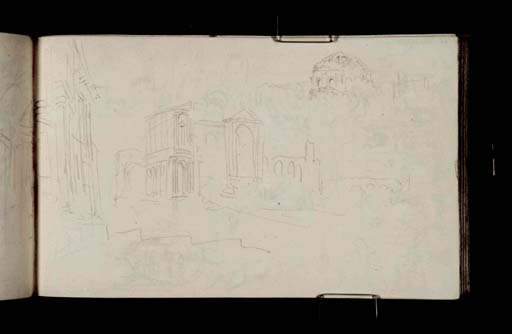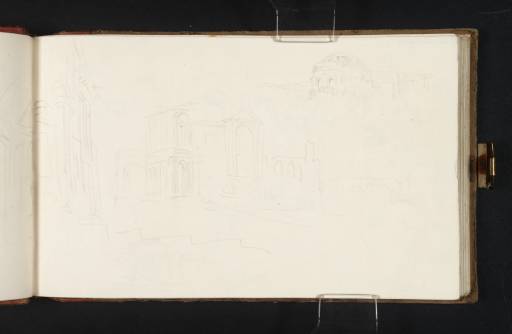Joseph Mallord William Turner The Triclinio Leoniano and the Scala Santa, Rome, from the Steps of San Giovanni in Laterano; and Ruins of the Temple of Minerva Medica 1819
Image 1 of 2
-
 Joseph Mallord William Turner, The Triclinio Leoniano and the Scala Santa, Rome, from the Steps of San Giovanni in Laterano; and Ruins of the Temple of Minerva Medica 1819
Joseph Mallord William Turner, The Triclinio Leoniano and the Scala Santa, Rome, from the Steps of San Giovanni in Laterano; and Ruins of the Temple of Minerva Medica 1819 -
 Joseph Mallord William Turner, The Triclinio Leoniano and the Scala Santa, Rome, from the Steps of San Giovanni in Laterano; and Ruins of the Temple of Minerva Medica 1819 (Enhanced image)Enhanced image
Joseph Mallord William Turner, The Triclinio Leoniano and the Scala Santa, Rome, from the Steps of San Giovanni in Laterano; and Ruins of the Temple of Minerva Medica 1819 (Enhanced image)Enhanced image
Joseph Mallord William Turner,
The Triclinio Leoniano and the Scala Santa, Rome, from the Steps of San Giovanni in Laterano; and Ruins of the Temple of Minerva Medica
1819
Joseph Mallord William Turner 1775–1851
Folio 88 Verso:
The Triclinio Leoniano and the Scala Santa, Rome, from the Steps of San Giovanni in Laterano; and Ruins of the Temple of Minerva Medica 1819
D16318
Turner Bequest CLXXXVIII 87 a
Turner Bequest CLXXXVIII 87 a
Pencil on white wove paper, 114 x 189 mm
Accepted by the nation as part of the Turner Bequest 1856
References
1909
A.J. Finberg, A Complete Inventory of the Drawings of the Turner Bequest, London 1909, vol.I, p.561, as ‘Ruins of Temple of Minerva Medica; also – The Logge of the Vatican’.
The subject of the main composition on this page is not, as Finberg suggested, the Loggia of the Vatican. Instead it depicts the Triclinio Leoniano (Triclinium of Pope Leo III), a surviving fragment of apsed wall from the dining room of the old Lateran Palace, as seen from the steps of the cathedral of San Giovanni in Laterano. The wall was reconstructed by with a triangular pediment by Pope Benedict XIV in 1743 and decorated with mosaics.1 To the left is the side of the building containing the entrance to the Scala Santa, also part of the old Lateran Palace, said to be the stairs from the house of Pontius Pilate ascended by Christ during his trial.2 Meanwhile, the arches in the background represent ruined sections of the Aqua Claudia, an aqueduct built by the Emperor Claudius which converged with the city walls at nearby Porta Maggiore (also called the Porta Prenestina). Compare a similar view in a sketch by Jean Auguste Dominique Ingres (1780–1867), The Building of the Scala Santa and the Triclino Leoniano next to S. Giovanni in Laterano c.1806–20 (Musée Ingres, Montauban, France).3
In the top right-hand corner is a separate sketch of the so-called Temple of Minerva Medica, a circular ruin which stands near the present-day railways tracks leading into Termini station in between the Porta Maggiore and the Porta San Lorenzo, see folio 88 (D16317; Turner Bequest CLXXXVIII 87). Popularly deriving its name from a statue found on site depicting the goddess Minerva with a snake (representative of the medical symbol of the caduceus) the circular structure has also been variously described as a nymphaeum or bath house and a dining pavilion.4 For other sketches and a general discussion see the Albano, Nemi, Rome sketchbook (Tate D15401; Turner Bequest CLXXXII 55).
Nicola Moorby
January 2009
How to cite
Nicola Moorby, ‘The Triclinio Leoniano and the Scala Santa, Rome, from the Steps of San Giovanni in Laterano; and Ruins of the Temple of Minerva Medica 1819 by Joseph Mallord William Turner’, catalogue entry, January 2009, in David Blayney Brown (ed.), J.M.W. Turner: Sketchbooks, Drawings and Watercolours, Tate Research Publication, December 2012, https://www

